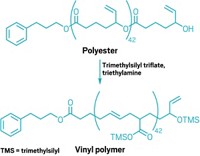Advertisement
Grab your lab coat. Let's get started
Welcome!
Welcome!
Create an account below to get 6 C&EN articles per month, receive newsletters and more - all free.
It seems this is your first time logging in online. Please enter the following information to continue.
As an ACS member you automatically get access to this site. All we need is few more details to create your reading experience.
Not you? Sign in with a different account.
Not you? Sign in with a different account.
ERROR 1
ERROR 1
ERROR 2
ERROR 2
ERROR 2
ERROR 2
ERROR 2
Password and Confirm password must match.
If you have an ACS member number, please enter it here so we can link this account to your membership. (optional)
ERROR 2
ACS values your privacy. By submitting your information, you are gaining access to C&EN and subscribing to our weekly newsletter. We use the information you provide to make your reading experience better, and we will never sell your data to third party members.
Synthesis
Helical Polymers Under Stereocontrol
Attaching chiral pendant groups to a polyphenylacetylene backbone allows reversible control over the polymer chain’s handedness
by Stuart A. Borman
February 1, 2010
| A version of this story appeared in
Volume 88, Issue 5

Polyphenylacetylenes, developed in the 1970s by Virgil Percec of the University of Pennsylvania and coworkers, adopt left- and right-handed forms. The polymers are under active investigation as possible molecular devices, chiral catalysts, and memory elements, among other uses, and their helical sense can be switched by changes in temperature, light, or solvent. But those control techniques are difficult, or they require that the polymer be bound to a surface—and none is reversible. José M. Seco, Ricardo Riguera, and coworkers of the University of Santiago de Compostela, in Spain, now report reversibly controlling polyphenylacetylene helicity by attaching chiral phenylglycine methyl ester pendant groups to the polymer backbone and then changing the conformation of the pendant groups by adding or removing Ba2+ or by modifying solvent polarity (Angew. Chem. Int. Ed., DOI: 10.1002/anie.200905222). The researchers propose a detailed mechanism by which the Ba2+ induced conformational change is transmitted to the polymer backbone. This is “a premier” study, Percec comments, noting that the reversible nature of the process could make the system useful for sensor applications.





Join the conversation
Contact the reporter
Submit a Letter to the Editor for publication
Engage with us on Twitter